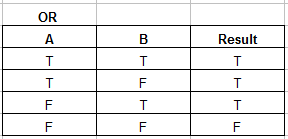Please read this logic problem before you read the answer: Click here.
回答を読む前に問題のみを読む場合は、上のリンクをクリックして下さい。






Honestants and Swindlecants II
正直者と嘘つき その2
One of the aborigines (Let's call him aborigine-1.) makes a propositional statement: "I am a Swindlecant or the other one (aborigine-2) is an Honestant."
原住民の一人が、「私(アボリジニ-1)がスウィンドルキャントであるか、或いは、もう一人(アボリジニ‐2)がオネスタントである。」という命題を述べます。
Within this propositional statement,
First statement A is: Aborigine-1 is a Swindlecant
Second statement B is: Aborigine-2 is an Honestant.
この命題の中に、
一つ目の陳述(A)が、「アボリジニ‐1が、スウィンドルキャントである。」
二つ目の陳述(B)が、「アボリジニ-2が、オネスタントである。」
が、あります。
Since the above two statements are combined with an "OR" operator, the truth table is as follows.
これら二つの陳述が、OR、つまり「或いは」で結ばれているので、真偽の表は、以下のとおりになります。

Now, let's examine each case.
さて、各々のケースを検討してみましょう。
1) A: F B: F -> Proposition F
If A is false, aborigine-1 is an Honestant.
If B is false, aborigine-2 is a Swindlecant.
Because the entire propositional statement is false, aborigine-1 must be a Swindlecant, telling a lie. This does not fit the assumption of aborigine-1 being an Honestant.
This assumption does not work.
1)A が偽、B が偽 -> 命題 偽
もし、陳述 A が偽であるなら、アボリジニ-1 はオネスタントとなる。
もし、陳述 B が偽であるなら、アボリジニ-2はスウィンドルキャントとなる。
しかし、命題が偽であるため、アボリジニ-1 がスウィンドルキャントとなり、オネスタントであるという仮定に合いません。
よって、このケースは、仮定が間違いです。
2) A: F B: T -> Proposition T
If A is false, aborigene-1 is an Honestant.
If B is true, aborigine-2 is an Honestant.
And in this case, the propositional statement is true, so this fits the assumption of aborigine-1 being an Honestant.
This works.
2)A が偽、B が真 -> 命題 真
もし、陳述 A が偽であるなら、アボリジニ-1 はオネスタントとなる。
もし、陳述 B が真であるなら、アボリジニ-2はオネスタントとなる。
そして、命題が真であるため、アボリジニ-1 がオネスタントであるという仮定に合います。
よって、このケースは、論理にかなっています。
3) A: T B: F -> Proposition T
If A is true, aborigine-1 is a Swindlecant.
If B is false, aborigine-2 is an Swindlecant.
And in this case, the propositional statement is true, which makes the aborigine-1 to speak the truth, but it does not fit the assumption of him being a Swindlecant.
This case does not work.
3)A が真、B が偽 -> 命題 真
もし、陳述 A が真であるなら、アボリジニ-1 はスウィンドルキャントとなる。
もし、陳述 B が偽であるなら、アボリジニ-2 はスウィンドルキャントとなる。
そして、命題が真であるため、アボリジニ-1 が真実を言ったことになり、彼がスウィンドルキャントであるという仮定に合いません。
よって、このケースは、仮定が間違いです。
4) A: T B: T -> Proposition T
If A is true, aborigine-1 is a Swindlecant.
If B is true, aborigine-2 is an Honestant.
In this case, also, the propositional statement is true, which has the aborigine-1 speaking the truth, which does not fit the assumption of him being a Swindlecant.
This case does not work.
4)A が真、B が真 -> 命題 真
もし、陳述 A が真であるなら、アボリジニ-1 はスウィンドルキャントとなる。
もし、陳述 B が真であるなら、アボリジニ-2 はオネスタントとなる。
そして、命題が真であるため、アボリジニ-1 が真実を言ったことになり、彼がスウィンドルキャントであるという仮定に合いません。
よって、このケースは、仮定が間違いです。
Since we examined all cases and found only one case that is logically correct in case 2), both aborigines are Honestants.
私たちは、全てのケースを網羅し、ケース2)だけが論理的に正しいことをみつけました。よって、いずれの原住民もオネスタントであるという結論を導きました。
I will announce the nicknames of those who answered correctly in my next article.
次回の記事で正解者のニックネームを発表致します。
PearTree/ペアツリー

ランキングに参加中です。ご協力お願いします。にほんブログ村&人気ブログランキング
Twitter@SC010101

Copyright 2011© by PearTree All rights reserved.